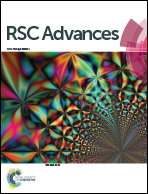Variations in the 5D0 → 7F0–4 transitions of Eu3+ and white light emissions in Ag–Eu exchanged zeolite-Y†
Abstract
The variations in the 5D0 → 7FJ(J=0–2) transitions of Eu3+ in the 580–630 nm range can reveal the exchanged-ion distribution within the zeolite pores for Ag–Eu exchanged zeolite-Y. A laser could excite more Eu3+ ions at symmetric sites (SI, SU) in the cages deep inside the zeolite besides activating those at the shallow surface. Significantly, the 5D0 → 7F4 transition of Eu3+ at 696 nm can be selectively modulated and enhanced by laser beam compared to xenon light according to the intensity ratio and decay-lifetime ratio of 5D0 → 7F4 to 5D0 → 7F2 transitions, which could be ascribed to the dynamic coupling effect on Eu3+ for the polarization of Eu3+-coordinated chemical environment induced by laser. Both transitions are determined by the odd-rank static electric field parameters of Eu3+ site according to the point charge model, but the 5D0 → 7F4 transition is further influenced by the polarizability of chemical environment around Eu3+ following the covalent bond model. Such strengthened effect may be partially relevant to the electronegativity of the zeolite framework. White light emission is achieved in these composites for excitation of both the 266 nm xenon lamp and laser, while the latter shows better tuning behaviors. The Ag–Eu codoped zeolite composites have potential applications in white light illumination.


 Please wait while we load your content...
Please wait while we load your content...